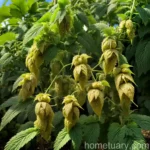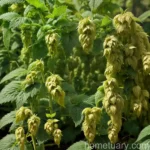The Marvelous Common Hop (Humulus lupulus ‘Aureus’)
Introduction
As a plant scientist, I find great pleasure in studying and understanding the diverse world of plants. Each plant species exhibits unique characteristics that make them fascinating subjects of study and admiration. In this article, we will delve into the remarkable attributes of the common hop, scientifically known as Humulus lupulus ‘Aureus.’ This plant is not only captivating in its appearance but also possesses a wealth of cultural, medicinal, and culinary significance.
Humulus lupulus ‘Aureus’ Characteristics
- Family: Cannabaceae
- Genus: Humulus
- Species: lupulus
- Cultivar: Aureus
- Common Name: Common Hop
Common Hop Plant Information
The common hop, also known by its botanical name Humulus lupulus, is a perennial climbing plant that belongs to the Cannabaceae family. It is characterized by its attractive golden foliage, making it a visually striking addition to gardens and landscapes. This plant is renowned for its association with beer brewing, as its cones are used to impart the bitter, zesty flavors and aroma to this popular beverage.
Growing Humulus lupulus ‘Aureus’
When it comes to growing Humulus lupulus ‘Aureus’, it is important to consider its specific requirements to ensure its optimal growth and development. Let’s explore the key aspects related to cultivating this mesmerizing plant.
Hop Plant Care Guide
Proper care is essential for the healthy growth of common hop plants. Here are some essential care guidelines that enthusiasts should observe:
Water
– Adequate watering is crucial, especially during the plant’s initial establishment phase.
– It is essential to maintain consistently moist soil, as this supports vigorous growth.
Sunlight
– Common hop plants thrive in full sun to partial shade.
– Ensure they receive at least 6 hours of direct sunlight daily for best results.
Fertilizer
– These plants benefit from a balanced, slow-release fertilizer applied in early spring.
– Consider using organic fertilizers to promote overall plant health.
Soil
– Well-draining soil is essential to prevent waterlogging, which can adversely affect the plant’s root system.
– A slightly acidic to neutral soil pH range is preferred for optimal growth.
Pruning
– Regular pruning is necessary to manage the plant’s vigorous growth.
– Proper pruning promotes airflow and reduces the risk of diseases.
Propagation
– Common hop plants can be propagated through rhizome division, cuttings, or seeds.
– Each method has its specific requirements and benefits.
Container Popularity
– Common hop plants are popular choices for container gardening, thanks to their climbing nature and aesthetic appeal.
– Growing them in containers also facilitates better control over their growth and spread.
Container Common Diseases
Despite their resilience, common hop plants can be susceptible to certain diseases. It is essential to be vigilant and proactive in disease management, as prevention is often more effective than cure.
Disease Diagnosis
Being alert to the signs of common hop diseases is critical for prompt intervention. Regular inspections should be conducted to detect any symptoms of diseases such as downy mildew, powdery mildew, or verticillium wilt.
Common Pests
Pests can pose significant threats to common hop plants, potentially impacting their growth and yield. They include aphids, spider mites, and hop flea beetles, among others.
Botanist’s Tips
Here are some valuable tips for cultivating and caring for Humulus lupulus ‘Aureus’ based on botanical insights:
– Periodic monitoring of soil moisture is essential, especially during hot and dry periods.
– Utilize natural predators such as ladybugs and lacewings for managing pest populations.
– Composting can contribute to the overall health of common hop plants by enriching the soil with essential nutrients.
Fun Facts
- The golden foliage of Humulus lupulus ‘Aureus’ adds a delightful touch of vibrancy to gardens and landscapes.
- Common hop plants have a fascinating history, deeply intertwined with the art of beer brewing and traditional medicine.
- Their climbing nature and lush foliage make them a delightful addition to trellises and arbors.
Links to External Resources
For more in-depth information on common hop plants, consider exploring the following resources:
1. Royal Horticultural Society – Humulus lupulus
2. University of Maryland Extension – Hops Production in Maryland
3. Oregon State University – Growing Hops in the Home Garden
Conclusion
In conclusion, the common hop plant, Humulus lupulus ‘Aureus,’ is a captivating botanical specimen with a rich tapestry of cultural, medicinal, and horticultural significance. Whether adorning gardens, contributing to the art of brewing, or demonstrating its resilience in the face of pests and diseases, this plant exemplifies nature’s marvels. By understanding and appreciating its distinct characteristics and needs, enthusiasts can cultivate and cherish this remarkable plant, adding a touch of allure and tradition to their surroundings.















